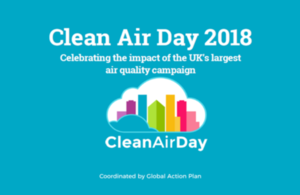Clean Air Day 2018: UK's largest air pollution campaign
The UK's largest annual air pollution campaign culminated in a day of mass public engagement, enabling the public to improve air quality and their health.

Clean Air day 2018 logo
Background
Clean Air Day is coordinated by Global Action Plan, on behalf of 200 Supporter organisations, including royal medical colleges, NHS trusts, local authorities, universities and health charities.
It brings together individuals, communities, businesses, education and the health sector to:
- improve public understanding of the sources of air pollution, both indoors and outdoors
- build awareness of how air pollution affects our health
- explain some of the easy things we can all do to tackle air pollution
- encourage people to try something different and make lifestyle choices that help to protect the environment and health too
Global Action Plan believes that people’s choices and voices have a crucial role to play in tackling air pollution. Choosing to drive less, switch to electric vehicles, and burn less fuel at home, for example, can help to bring down pollution to safer levels.
What was involved
-
Public information portal: www.cleanairday.org.uk is the UK’s go-to public information website on air pollution with easily accessible advice (agreed by PHE, RCP, RCPCH and KCL) and ‘how to’ guides for organisations wanting to take part in Clean Air Day.
-
Face-to-face: we support organisations across the country to encourage pollution-busting behaviour and the sharing of information on air quality and health through face-to-face activities.
-
Press and social media: through stories in the media and a social media campaign, we generate public interest, promoting pollution-cutting behaviour and encouraging the sharing of information on air quality and health.
The 2018 campaign got off to a brilliant start with a story about the London Marathon in late April. Global Action Plan’s research revealed a massive 89% drop in the capital’s air pollution on the day of the Marathon when the streets were closed off to traffic.
Over the following months we went on to reveal new research about:
- awareness of the dangers of air pollution in our homes
- how car engine cold starts double air pollution
- the health costs of air pollution from cars and vans
- how young children are being exposed to 30% more air pollution than adults while walking to school
What went well
In 2018, more than 2,000 organisations, and tens of thousands of individuals took part in more than 550 events across the UK.
Many people took up the Clean Air Day challenge to walk or cycle to work, college or school.
In Edinburgh, they closed off the Mound to traffic for the morning, landscaping and installing benches to make the area more pedestrian-friendly. In Manchester, a hospital ran free bike maintenance sessions for its 3,000 staff.
Portsmouth gave away free park-and-ride tickets to encourage people to use more public transport.
In Lambeth, London, as part of a week of events, a school installed a screen of ivy to protect it from pollution from a nearby road.
The campaign generated more than 1,750 media items and 50,000 social posts, including those from MPs and ministers. Total media and social media reach was more than 950 million for the 2018 campaign, and on Clean Air Day itself, #cleanairday trended on Twitter for 8 hours.
Did all this attention work? Before, and after, Clean Air Day opinion polls indicated that public understanding of key air pollution issues increased over the period of the campaign. And more people started doing things to cut air pollution.
Findings included more awareness of the dangers of indoor air pollution following the campaign, up by 12% to 74% of respondents, while 45% people questioned are now aware that cyclists and pedestrians often breathe cleaner air than drivers.
The same findings revealed that 22% chose to cycle or walk a route they had previously driven, compared to 16% before the campaign, an increase of 37%, and 71% now open windows for ventilation when they are cooking or cleaning, an increase of 22%.
What could be improved
Having consulted Clean Air day supporters and participants in 2018, key improvements for 2019 include:
- providing campaign materials as early as possible (ideally at least 6 months in advance) so organisations can more easily incorporate them into plans and activities
- creating editable marketing materials (such as posters and leaflets) so they can be customised
- encouraging people to rethink their habits for the everyday, not just for one day a year
- providing more ‘how to’ guidance to help organisations transition from awareness raising to behaviour change
- encouraging everyone who took part in 2018 to step up for 2019 and make their participation even bigger
A full evaluation can be found on the Clean Air Day website.
Next steps
Clean Air Day 2019 is on Thursday 20 June. The campaign for cleaner air, however, is not just for one day every summer, but 365 days a year.
Global Action Plan, as the coordinator of the campaign, is working to secure funding to ensure everyone has the information they need about air quality so they can lead their lives in the most non-polluting and health-enhancing way.
Further information
Larissa Lockwood, Head of Health, Global Action Plan